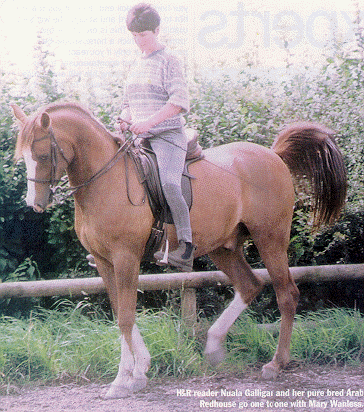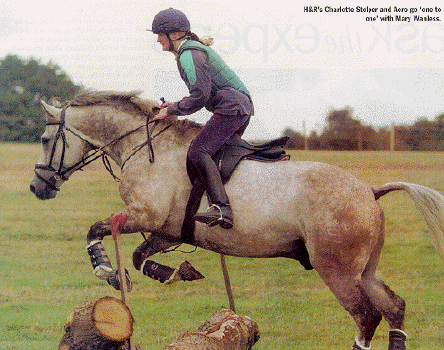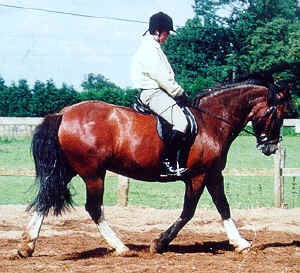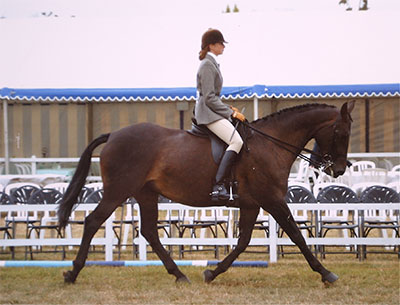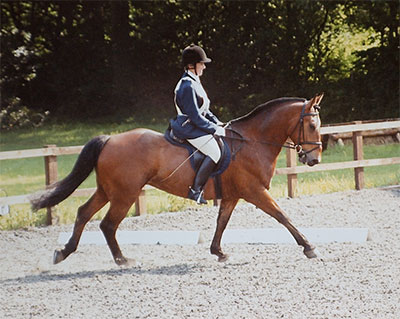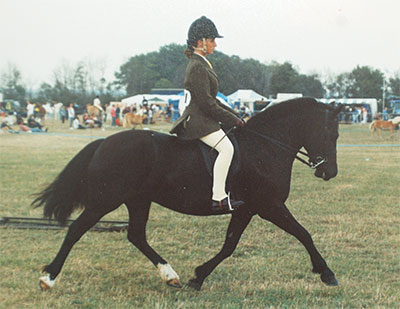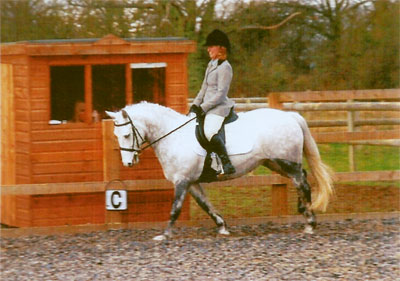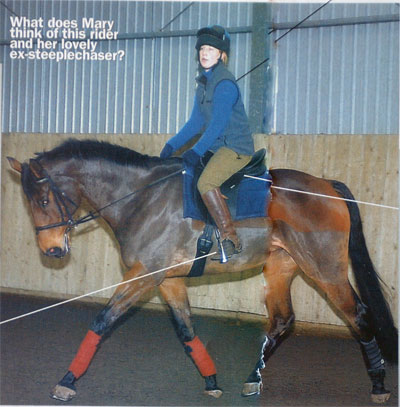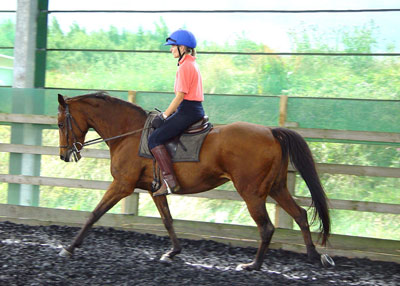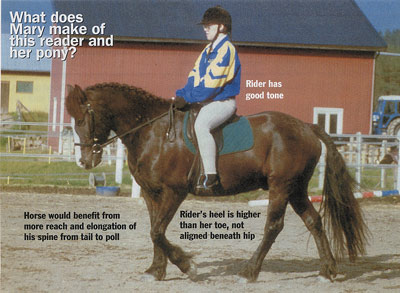RWYM
ARTICLE 36
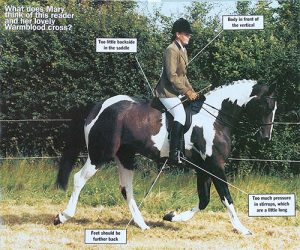 This handsome horse is a four year old, sired by a warmblood, and out of a polo pony mare. He has been with his present rider since he was a yearling. She rides him in showing classes, and in affiliated novice dressage competitions, She tells me that ‘ I have been riding since childhood, but still feel the need to gain more confidence and suppleness while riding….riding brings on severe back pain which I feel is the result of years of stiffness and lack of seat.’
This handsome horse is a four year old, sired by a warmblood, and out of a polo pony mare. He has been with his present rider since he was a yearling. She rides him in showing classes, and in affiliated novice dressage competitions, She tells me that ‘ I have been riding since childhood, but still feel the need to gain more confidence and suppleness while riding….riding brings on severe back pain which I feel is the result of years of stiffness and lack of seat.’
Quite a large percentage of riders experience back pain, which they associate with riding, rather than with stable chores or accidents. Helping these riders has led me to the conclusion that back pain is often self-inflicted, and is the result of poor posture and riding skills. The good news is that until you reach the stage where this has led to structural damage, there is every chance of eradicating it through learning to ride well. In fact, riding well is potentially very strengthening for both your back and your abdominal muscles, and it can be preventative as well as restorative medicine What better way could there be of killing two birds with one stone?
I perceive riding skills as being much more about what happens with the rider’s pelvis and torso than with her hands and legs. Whilst this might seem obvious, the literature of riding tells us far more about ‘this hand here and that leg there’ than it does about the rider’s core. Good riders organise the centre of their body so well and so instinctively that they do not know what they do – and even if you do know (as I do), I can assure you that talking about what happens in the core is far harder than describing the extremities!
However, there has been much validation recently for the idea that the centre of the body houses the hidden elements of riding skills. Within the world of fitness, there is currently great emphasis being placed on core muscle strength and core stability. The Pilates system is built around this concept, and work with gymnastic balls (which is becoming more and more popular in gyms) is again aimed at developing the core muscles. The control and mobility of the extremities are determined here, so even the Williams sisters utilise this approach to become fitter and better tennis players.
Years ago, if you had back pain, physiotherapists put you in a corset. Now they train you so that your own muscles become your corset. With strong abdominal muscles, your spine is not pulled forward by your sagging belly, and this eradicates the cause of much back pain. Problems also result when your back is overly rounded, for anything that pulls your spine away from its ideal ‘neutral’ alignment (in which the spinal curves are balanced) is potentially pain-inducing and damaging.
Our rider thinks that her problem is ‘stiffness’ and than the answer lies in more ‘suppleness’. This is certainly the traditional language and ethos of the horse world. But riders do not need the suppleness of a dancer, who moves her body through a huge range of motion. Whilst a rider’s joints need to ‘give’, they work only within a very small range. Meanwhile, the parts between the joints remain stable, and there is no ‘wiggle in the middle’ of the back (which is some people’s mistaken definition of suppleness). Good riders do not do this. Their movement is restricted to their hip, knee, and ankle joints, and their spine is held still, supported by that strong girdle of muscles.
Let’s look specifically at our rider. I hope she is in rising rather than sitting trot. If so, she has made a very small rise, and has not matched the thrust of her horse’s hind leg. If she is sitting, I am more worried for her, since she is a long way in front of vertical, and has a lot of pressure in her stirrups with little of her backside in the saddle. Either way her hip angle is very closed, and I suspect that this is her nemesis.
If we took her horse out from under her by magic, it is not so clear as usual how she would land on the riding arena. I suspect that she would wobble a bit, and then tip backwards in a folded-up kind of way. It is almost as if her body wants to fold towards jumping position. Her jacket obscures the line of her back, but she is probably rather hollow.
I would really like to get my hands on this rider, and do the realignment that would bring her into a shoulder/hip/heel vertical line. I would teach her to bear down (the correct use of her abdominal muscles, which I have explained in previous articles), and would make sure that her weight was taken much less in her stirrups and more on the whole suede area of her breeches. I might decide to take her stirrups up a hole. From the angle of the photograph it is hard to judge whether her thigh is indeed more vertical than 45 degrees to the ground (its ideal angle), but I suspect that it is.
If you think of the spine as a flexible mast that is held up by guy ropes, the guy ropes at the front of her body are shorter than those at the back. This means that however hard she tries to keep her shoulders more back, sooner or later she will topple forward again. It can help to think of evening out the tension of the guy ropes, so that the front is as long as the back. It can also help to think of someone floating along behind you with their hands on your shoulders, drawing your shoulders back.
The effort of keeping both her shoulders and her feet back will be a big deal (in both rising and sitting trot as well as canter), as will the effort of bringing her backside more forward and underneath her. It might also help our rider to think of limbo dancing, as this would counteract its inbuilt fold.
Riders who tend to fold up like this often imagine that the hinge of the hip joint lies at the front of the body, directly in the angle between the torso and thigh. Locate this wrong place by sitting upright with your legs uncrossed, and putting the edge of your hand in this angle. Then fold forward with your back straight. Next, use your finger tips to locate the greater trochanter of the femur, which is a bony knobble that lies at the top of the thighbone on the outside of the thigh just where your pants begin. If you lean to one side and then to the other you should be able to find it. (Stand up to do this if necessary.) Put the tip of your middle finger on this knobble. Your hip joints are actually within your torso, slightly higher up than this knobble, and about half way between your back and your front.
Thinking of the hinge of the hip joint being further back inside you can be an enormous help. It automatically helps you to keep the front angle open, and not to lock the hip joint. When you are riding well, there are small movements in this angle. Once you can maintain a decent alignment in sitting trot, and will not make the traditional mistakes of trot/walk transitions, (which I have talked about elsewhere) ride some transitions whilst thinking of stopping the movement in this angle. Realise how effective this is in stopping the horse, and contrast it with the movement there needs to be here as you maintain trot. Realise how stopping the movement (small though it is) stops your horse from moving too.
I suspect that our rider has got her hip joints locked up, and that the knock-on effects of this are making her back hurt. I hope she will get hands-on help from myself or one of my colleagues, as I think she will need an outside eye to help her find her way out of her present pattern. ‘Neutral spine’ and bearing down could, quite literally, get her out of pain. (One rider even threw her walking stick away, and decided that she did not need surgery!) Various bodywork options may also help, from Alexander lessons to Yoga, Pilates, or sports massage. Stretches, particularly for the quadriceps muscles (at the front of the thigh), and the psoas muscles (which lie within the torso), will benefit her too, although she needs good tuition to ensure that she does them correctly.
I do hope that she will make some choices that will help herself (and her horse). Life is too short, and riding too precious, to have it marred by pain – especially given the remarkable number of occasions in which the answer is actually very simple.


